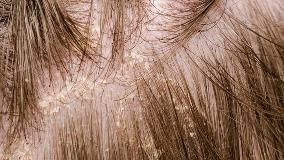Dandruff occurs, essentially, when small bits of dry skin are shed from the scalp. You might spy these flakes in your hair or on your shoulders. Dandruff may make your scalp itchy, too. It’s a common problem, but it isn’t as simple as it seems. Dandruff is actually quite tricky to define because it overlaps with seborrheic dermatitis (a chronic form of eczema) and other skin conditions that lead to a scaly scalp. Here’s what you need to know.
Causes and Risk Factors of Dandruff
Dandruff can happen for a number of reasons:
Almost anyone can have dandruff, but certain factors can make you more susceptible, including:
Shampooing Habits “For those who are already at risk for dandruff, washing infrequently can worsen the condition,” says Dr. McMichael. Taking extended breaks can lead to a buildup of oil that can lead to dandruff.
Oiling Your Scalp “Certain oils applied to the scalp can cover the scale, but worsen the flaking and itching response,” notes McMichael.
Duration of Dandruff
Prevention of Dandruff
Research and Statistics: How Many People Get Dandruff?
Resources We Love
Skin of Color Society
This professional dermatologic organization is dedicated to promoting awareness of (and excellence within) the dermatological care of skin of color. SCS offers a Find a Doctor database to help those of Asian, Hispanic or Latino, African, Native American, and Pacific Island descent find local dermatologists who are especially knowledgeable about their skin concerns. Whether you’re struggling to find a dermatologist who can help treat persistent dandruff in Black hair or you’ve got another skin-related issue, SCS’s Find a Doctor database can help.
American Academy of Dermatology
The AAD is the largest dermatology group in the United States and its website is full of resources, tips, and more. Curious how to ease your itchy skin? Check out their Everyday Care section. Craving some insider secrets to tackle your rosacea? Try the AAD’s Diseases and Conditions area. Not sure how to combat your child’s dandruff? Go to the areas dedicated to Parents and Kids.
Editorial Sources and Fact-Checking
- Seborrheic Dermatitis. Merck Manuals: Consumer Edition. March 2018.
- Seborrheic Dermatitis. American Osteopathic College of Dermatology.
- Seborrheic Dermatitis. National Eczema Association.
- Hewitson KS, Vullo D, Scozzafava A,et al. Molecular Cloning, Characterization, and Inhibition Studies of a B-Carbonic Anhydrase From Malassezia Globosa, a Potential Antifungal Target. Journal of Medical Chemistry. March 19, 2012.
- Wikramanayake TC, Borda LJ, Miteva, M, Paus R. Seborrheic Dermatitis — Looking Beyond Malassezia. Experimental Dermatology. July 16, 2019.
- 10 Reasons Your Scalp Itches And How To Get Relief. American Academy of Dermatology Association.
- The Facts about Dandruff. PIH Health. April 12, 2019.
- Seborrheic Dermatitis. Cleveland Clinic. May 29, 2020.
- Borda LJ, Wikramanayake TC. Seborrheic Dermatitis and Dandruff: A Comprehensive Review. Journal of Clinical and Investigative Dermatology. December 2015.
- Sweating and Other Skin Problems in People with Parkinson’s Disease. American Parkinson’s Disease Association. July 23, 2019.
- Seborrheic Dermatitis Diagnosis and Tests. Cleveland Clinic. May 29, 2020.
- Dandruff Diagnosis and Treatment. Mayo Clinic. September 11, 2019.
- Dandruff. American Osteopathic College of Dermatology.
- Dandruff Treatments. Northwestern Medicine.
- Drugs and Supplements Ketoconazole (Topical Route): Description and Brand Names. Mayo Clinic. August 1, 2020.
- Seborrheic Dermatitis: Management and Treatment. Cleveland Clinic. May 29, 2020.
- What Is the Best Way to Treat Severe Dandruff? Harvard Health Publishing. May 2017.
- Satchell AC, Saurajen A, Bell C, Barnetson RS. Treatment of Dandruff with 5 percent Tea Tree Oil Shampoo. Academy of Dermatology. December 1, 2002.
- Barak-Shinar D, Green LJ. Scalp Seborrheic Dermatitis and Dandruff Therapy Using a Herbal and Zinc Pyrithione-Based Therapy of Shampoo and Scalp Lotion. The Journal of Clinical and Aesthetic Dermatology. January 2018.
- Dandruff: What It Is and What to Do About It. Cedars Sinai. September 25, 2019.
- Gathers RC, Mahan MG. African American Women, Hair Care, and Health Barriers. Journal of Clinical and Aesthetic Dermatology. September 2014.
- Elewski BE. Clinical Diagnosis of Common Scalp Disorders. Journal of Investigative Dermatology Symposium Proceedings. December 1, 2005.
- Cradle Cap (Seborrheic Dermatitis) in Infants. Kids Health. February 2019.
- Ringworm (Scalp) Symptoms and Causes. Mayo Clinic. March 7, 2018.













































